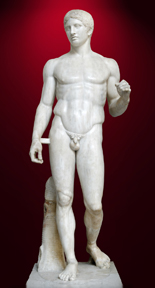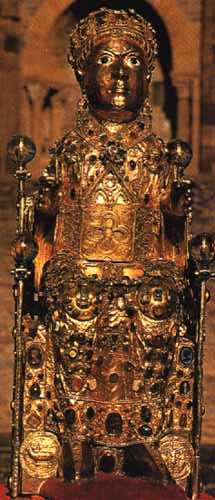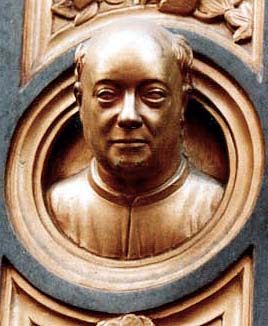|
The Rise of the Artist — NOTES
Art and the Artist before the Renaissance
- Classical culture - ancient Greece and Rome - did not have a specific term for art - only the word techne (Greek) ["technique/technical" = mechanical skill in artistic work] and ars (Latin)
Both terms could be applied to all kinds of human activities - most of which we would now tend to call crafts or sciences: e.g. carpentry, agriculture, medicine
- An essential feature of techne was rules
because of rules, techne stood above routine and was opposed to such things as instinctive ability, and mere chance
techne was something that proceeded by rational principles and rules and involved deliberate human choice
- For Aristotle, techne was purposeful - geared towards production. It could apply as much to carpentry as to painting
The Greeks used rules to bring order to the world around them
they consciously sought order, clarity, balance, harmony in their art (or what we would call art) - they sought control, and ultimately comprehension
- In this situation - accordingly: artists (or those whom we might call artists today) differed merely in their competence or capability in applying the rules.
The Greeks did not necessarily recognize art as being what we might call "the personal expression of an individual."
A painter or a sculptor was admired for how well he mastered the rules, for his technique and skills (i,e, his practical, craftsman's ability)

Polyclitus, Doryphorus
The Problem of the Artist
GREECE and ROME
- In ancient Greece - a sculptor or a painter was called a banausos (or ‘mechanic’) - a term which also carried a low and vulgar meaning - it was associated with manual work
An Ancient Greek prejudice against those who work with their hands, and who serve utilitarian interests
painters and sculptors worked as craftsmen - mechanics - according to established rules
- They were certainly NOT to be associated with poets and musicians
According to Plato, poets and musicians did not follow the rules of techne - but worked under "divine inspiration" (see below)
ART AND ARTISTS IN THE MIDDLE AGES
- As in antiquity - ambivalent attitudes towards the artist's social position and his activity
The sculptor and the painter were afforded little status throughout the Middle Ages - remained largely anonymous
- However, delight taken in the activities of painters and sculptors - but their products were not appreciated as art in our sense
As in antiquity - painting and sculpture were admired for their workmanship, for their use of colour, and gold, and precious stones
The sculptor or painter was judged on his skill and technique

Reliquary of St. Foy, Conques, c. 985
THE RENAISSANCE
- The Renaissance saw a concerted effort on the part of painters and sculptors to extricate themselves from the medieval heritage which lumped them together with craftsmen
- At the beginning of the Renaissance, the painter and sculptor were still regarded as craftsmen - they were usually uneducated, often ignorant, and sometimes illiterate
As a member of the artisan class, he occupied a low rung on the social ladder
- But, from the beginning of the 14th century - there is a steady rise in the position of the painter and sculptor - and a growing sympathy expressed for the visual arts
We see a new type of artist rising - with a new and developing consciousness of himself as an artist
This has to do, no doubt, with the complex phenomenon of the Renaissance itself - the new importance of the individual and the "dignity of man"
In this new climate we find the new artist believing himself to be superior to craftsmen, with whom he had for so long been associated
The painters and sculptors now wished to separate themselves from the craftsmen, and improve their social status

Lorenzo Ghiberti, Self-portrait
Gates of Paradise, Florence
- By the 15th century, it became the goal of painters and sculptors to attain recognition of their professions as liberal arts
- The system of the so-called "Liberal Arts" had been organized in late antiquity (after the time of Plato and Aristotle)
comprised seven areas of learning
- Arithmetic
- Geometry
- Astronomy
- Music
- Grammar
- Rhetoric
- Dialectic
The liberal arts were composed primarily of teachable knowledge - or "sciences" - they were theoretical, intellectual, and literary
- To win acceptance of painting and sculpture as liberal arts, the painters and sculptors began to claim that painting and sculpture were also theoretical, intellectual, and literary - and art begins to assume a "scientific" aspect
- Thus we find in the treatises of the period - e.g. Leon Battista Alberti - attention being given to the new "scientific" methods in painting and sculpture; and the notion that to be a painter or a sculptor, one needed a knowledge of different branches of learning [optics, perspective, anatomy]
Painting and Poetry
Horace, Ut pictura poesis ("As is painting, so is poetry")
poetry an established and dignified art during Middle Ages - painting consciously associated with poetry in Renaissance
Common theme of poetry and painting?
Claim that both the painter and the poet have the gift of free imagination
NOTE
Cennino Cennini, Craftsman's Handbook, first to formulate this idea -
"...painting, which calls for imagination...And it justly deserves to be enthroned next to theory, and to be crowned with poetry. The justice lies in this: that the poet, with his theory, though he have but one, it makes him worthy, is free to compose and bind together, or not, as he pleases, according to his inclination. In the same way, the painter is given freedom to compose a figure, standing, seated, half-man, half-horse, as he pleases, according to his imagination."
Painting derives this status from having the gift of inventive imagination (i.e. creativity)
painting and poetry came to be regarded as sister arts during Renaissance
Marsilio Ficino, "the madness of poets"
- According to Plato, poets and musicians did not follow the rules of techne - but worked under divine inspiration
to be inspried, to have inspiration - a term that originally meant to breathe or blow into (opposite of expire) - here understood as meaning to be filled with supernatural power or energy
- Poets were infused with enthousiasmos ("en-theism"), or divine inspiration
In effect, the gods inspired, or spoke through, the poets and musicians (and also prophets)
Prophet = "one who speaks for another" - a seer (an inspired poet)
To prophesy - to utter with divine inspiration
- Already in 15th century, we encounter the notion that painters should be thought of as akin to poets
RECALL: Horace's dictum: "ut pictura poesis"
Also Simonides: painting as "muta poesis" (mute poetry); poetry as "pictura loquens" (spoken painting).
Like Poets, painters claimed divine inspiration
In ancient Rome, the deity who supplied this inspiration was called genius. Notable achievements or high intellectual powers of an individual were attributed to his genius
Ultimately, a man of achievement was said to have genius, to be a genius. It was this attendant deity that inspired the poet
In the 16th–century Italy, Plato's notion of inspiration became associated with painters and poets
However, their source of inspiration was not some pagan deity, but claimed to be God himself
In other words, the artist could claim to be inspired in his work by God - and thus form a sort of link between the earthly and the divine
It is at this time that artists like Michelangelo get to be called divine: "Il Divino Michelangelo" - also Raphael
This also brings about the emergence of the concept of the artist as creator
|

